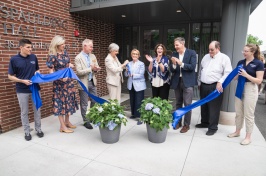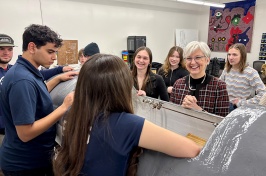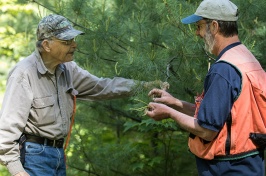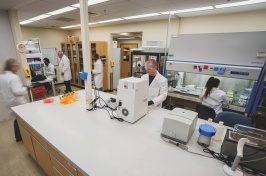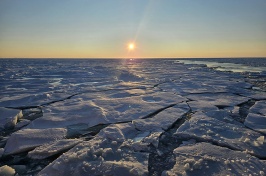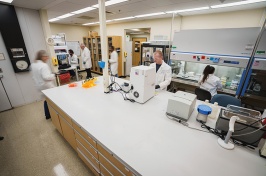The University of New Hampshire is a flagship research university that inspires innovation and transforms lives in our state, nation and world. More than 16,000 students from all 50 states and 71 countries engage with an award-winning faculty in top ranked programs in business, engineering, law, health and human services, liberal arts and the sciences across more than 200 programs of study. UNH’s research portfolio includes partnerships with NASA, NOAA, NSF and NIH, receiving more than $100 million in competitive external funding every year to further explore and define the frontiers of land, sea and space.
UNH Partners with Seacoast Science Center to Help Diagnose Cause of Deaths of Marine Mammals
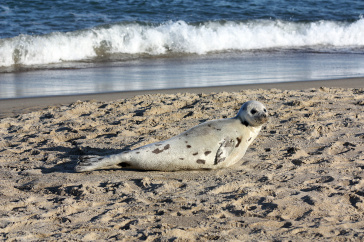
Harp seals like this one are born on pack ice in the arctic and Canadian Provinces and sometimes migrate to the East Coast during winter.
DURHAM, N.H.—The New Hampshire Veterinary Diagnostic Lab at the University of New Hampshire has partnered with Seacoast Science Center (SSC) Marine Mammal Rescue to help diagnose the cause of deaths of marine mammals found on the northern New England seacoast.
“We are so pleased to partner with the NH Veterinary Diagnostic Lab at UNH for diagnostic and necropsy services for marine mammal cases,” said SSC Marine Mammal Rescue Manager Ashley Stokes. “Prior to the partnership, specimens were sent to the New England Aquarium facility in Quincy, Mass. Having access to NHVDL/UNH will ensure quick and accurate diagnostics when the aquarium’s facility is at capacity or unable to take carcasses during sea turtle rescue season.”
According to Inga Sidor, senior veterinary pathologist with the NH Veterinary Diagnostic Lab, while the lab’s primary responsibility is to agricultural veterinary clients, the lab has expanded into work in wildlife species over the last decade.
“This work supports our emphasis on the concept of One Health, recognizing that human, wild and domestic animal, and ecosystem health are interdependent,” said Sidor, who has extensive experience in the field of marine mammal stranding and pathology. “This partnership with Seacoast Science Center formalizes our involvement with monitoring health and disease in Gulf of Maine marine mammal species.”
The NH Veterinary Diagnostic Lab recently took its first case through the partnership, performing a necropsy on a juvenile male harp seal found on the beach in Rye in late November. The seal was examined and tested for phocine distemper virus, which was responsible for the seal die-off this year on the Northeast coast. This virus is highly infectious and easily spread nose-to-nose among seals, in the same family as measles and canine distemper virus but cannot be transmitted to humans. According to Sidor, the investigation is ongoing, but preliminary test results were negative for viral infection, suggesting something else may have caused this seal’s death.
Mortality in marine mammals may be caused by a broad range of factors, including nutritional/environmental factors, entanglements and other human-related trauma, predators, as well as a variety of infectious agents, Sidor said. In seals in this region, disease can be one primary cause of stranding. While many infections are sporadic, experts do see occasional epizootics -- sudden, increased mortality of an infectious cause in animals -- of viral infections.
According to SSC Marine Mammal Rescue, this is the time of year that New Hampshire starts to see ice seals on its coast. Harp and hooded seals are born on pack ice in the arctic and Canadian Provinces and sometimes migrate to the East Coast during winter. Other seals seen in New England’s coastal region are harbor, gray, and hooded seals. It is normal behavior for seals to haul out onto the beach to rest. Whales, porpoise, and dolphins frequent the Gulf of Maine, but rarely strand on the beach.
Anyone who finds any marine mammal, live or dead, on the beach should call the Seacoast Science Center Marine Mammal Rescue hotline at (603) 997-9448.
The NH Veterinary Diagnostic Lab is co-managed by the state Department of Agriculture, Markets & Food and the New Hampshire Agricultural Experiment Station. Founded in 1887, the NH Agricultural Experiment Station at the UNH College of Life Sciences and Agriculture is UNH’s original research center and an elemental component of New Hampshire's land-grant university heritage and mission.
PHOTO AVAILABLE FOR DOWNLOAD
https://colsa.unh.edu/nhaes/sites/default/files/media/images/harpseal.jpg
Harp seals like this one are born on pack ice in the arctic and Canadian Provinces and sometimes migrate to the East Coast during winter.
-
Media Contact
Lori Tyler Gula, PhD | NH Agricultural Experiment Station | lori.gula@unh.edu | 603-862-1452
Latest News
-
June 25, 2025
-
June 16, 2025
-
June 6, 2025
-
May 15, 2025
-
May 14, 2025














